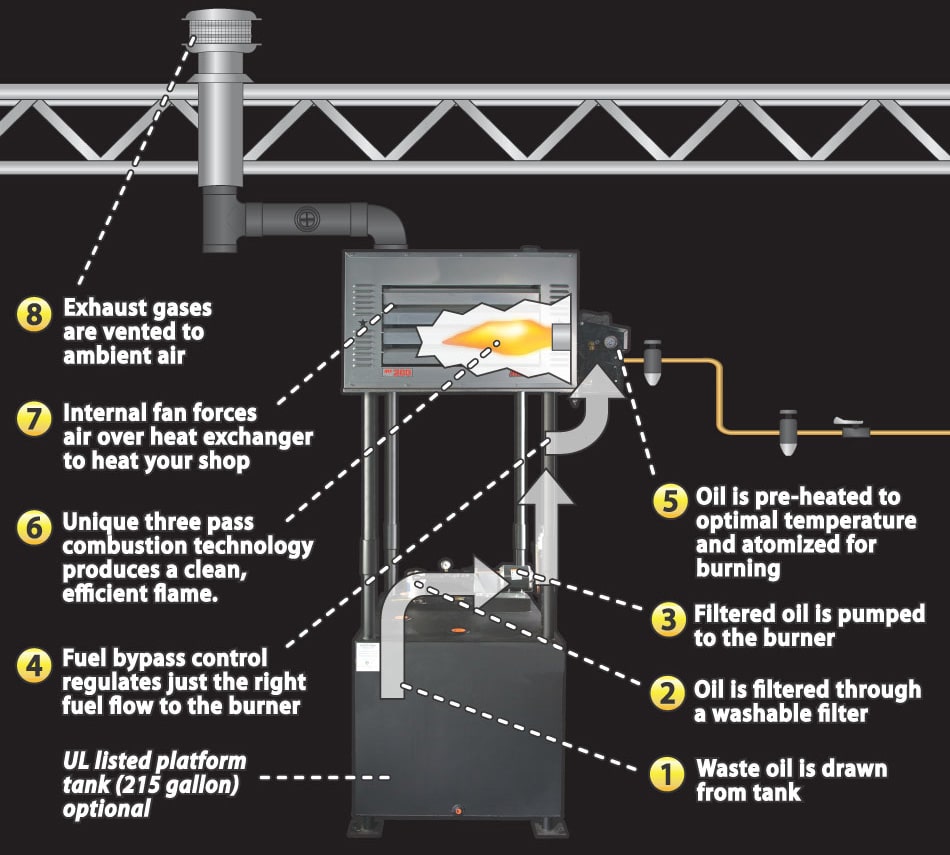All You Need to Know About Waste Oil Heaters

Waste oil heater has become a hot topic in the USA and Canada these days because this is an environment-friendly solution. It recycles waste oil that is to be dumped in the sea or in a dumping place. Recently, in my own neighborhood, I have noticed a number of people making their own homemade waste oil heaters to save money. And many of them, including the manufacturers, are promoting the waste oil heater as an “eco-friendly solution.” Well, this claim is worth checking and if there is any truth to this claim, that would certainly be appreciable. In this article, we are going to dissect how a waste oil heater works and if it is really that much good.
The Fuel of Waste Oil Heaters
Well, it is not hard to guess what the fuel of waste oil heater is. Any type of petroleum, synthetic oil that can’t be used for its intended purpose can be otherwise used as the main fuel source of waste oil heaters. Normally, factories and pump stations are the main sources of this type of oil. But households can also provide waste oil since you can use waste vegetable oil for waste oil heaters. However, it is the Environmental Protection Agency that is responsible for marking which kind of oil is safe to burn. So if you wish to burn any kind of oil that is not marked as safe, you have to get it tested first.
How Do Waste Oil Heaters Work?
Waste oil heaters work based o the combustion technology. The oil gets broken up into many small particles to release the heat energy. The working principle of waste oil heaters is explained below:

Image: How Does A Waste Oil Heater Work?
Waste oil heaters mainly have two parts – fuel tank and burner. The waste oil is stored in the fuel tank. At the pathway from the fuel tank to the burner, there is a filter which filters the waste oil to control the flow of fuel to the burner at a consistent level. This filter is washable and regular maintenance has a positive impact on the overall efficiency of the heater. The filtered fuel is preheated to an optimal temperature and atomized for burning before passing it to the combustion chamber. In the combustion chamber, clean and efficient flame is produced with atomized oil. Then carefully placed internal fans draw air to the flame to heat up and direct it towards the room space. The exhausted gas has to be vented away to have ambient air in the room by a proper ventilation system.
Waste Oil Heating – A Green Technology?
The waste oil heating technology is regarded as a revolutionary technology and the manufacturers of waste oil heaters are marketing them as a green technology that is beneficial to our environment. It’s time to assess their claim whether they are really a revolutionary green product.
Well, waste oil heating is helpful to our environment in the sense that it offers a way to recycle waste oils, which are to be dumped to the sea or other dumping areas. But waste oil heaters are not as green or environment-friendly as the manufacturers want you to think. Like all the oil burning heaters out there, waste oil heaters also produce gasses that are to be mixed with the open air.
Like other combustion heating technologies, waste oil heaters also produce gasses and toxins that are hazardous to our environment. In comparison to the conventional heaters, waste oil heaters produce toxins like cadmium, lead, arsenic, chromium, and much more. The reason behind this is that waste oil heaters use all kinds of motor oils which have detergents, lubricants, and many more unknown substances.
Another important thing to remember regarding waste oil heaters is that it might be illegal to use a waste oil heater in your state if you are burning any type of oil that is not marked safe by the EPA (Environmental Protection Agency).
The Cost Efficiency of Waste Oil Heaters
The cost efficiency of waste oil heaters is worth discussion since it is considered the main advantage point of them over other conventional heaters. It is true that waste oil heaters use waste oil as a fuel source, which is very cheap in comparison to oils. You can get waste oils from gas stations and different factories at a very cheap rate. But one loophole to this idea is that they also use electricity to generate heat. So it will be inaccurate if we just compare the waste oil price to determine the operating cost of waste oil heaters.
One more thing you need to know is that you may require a permit to use waste oil heaters depending on the region you are living in. The cost of having a permit would have an impact on the operating cost of waste oil heaters.
The main impediment of waste oil heaters is that their upfront cost is too high. This is because every waste oil heater is needed to be tested to ensure the safety of the users in the long run. Many would suggest building your own homemade waste oil burner at a minimal cost and you might find numerous manual on “how to make a drip feed waste oil heater.” But here at The Soothing Air we would recommend that you do not do this since there are many technical issues that need to be solved before starting any kind of combustion process. You can find more about this topic in the latter part of this article.
Disadvantages of Waste Oil Heaters
Although waste oil heaters have many advantages than other space heater types, they have some major disadvantages as well, including the following:
Heavy Metal Toxins
Waste oil heaters work on various types of oil. Because of this versatility of their fuel option these heaters are exposed to a lot of chemical substances. As a result, they produce more heavy metal toxins like cadmium, lead, arsenic or chromium than usual.
Excessive Maintenance
Waste oil heaters generally produce clean heat for garages, stores, or homes. But their heating efficiency usually depends on their technical fitness. These heaters require regular maintenance to ensure safety and efficiency. Most of the waste oil gets wasted when their chemical form gets corrupted somehow. This chemical impurity puts a tremendous pressure on the filter inside a waste oil heater. That is why it is mandatory to clean the filter at least twice a week.
Safety Issue
There are some safety concerns about waste oil heaters. First of all, by-product gasses released from the waste oil combustion process are hazardous to health if not vented properly. As you can guess, they are harmful to our environment as well. Moreover, if not maintained properly, waste oil heaters are more exposed to fire hazards or accidents than other heater types.
Are Homemade Waste Oil Heaters A Good Option?
If you are not an expert at the combustion heating process then our answer is a big NO. It may look very easy to build your own homemade waste oil heater after reading one or two blogs online, explaining how to make a drip feed waste oil heater or how to build a waste oil heater. But there are many technical issues that you have to face so as to ensure the overall safety of the heater, and one tiny mistake could lead to a fatal disaster in your home. There is a reason why industry-made waste oil heater models cost so much. However, if you are still thinking about building your own homemade oil burner heater you should consider the following issues:
- You should consider the self-ignition process in your waste oil boilers because hand lit ignitions are too risky to operate
- The oil burning heater should have an internal air compressor
- It must be kept safe from any flammable objects, like papers, clothes, or gasses
- The fuel tank must be rust-free and without any forms of leakage
- It must have a ventilation system
- The waste oil should be stored properly
- The heater must be properly maintained at least twice a week
Finally, the waste oil heating technology obviously has many positive features, such as the use of recyclable waste oils. But they are not as environment-friendly as many of us would believe. If you are looking for a cheap and energy efficient heating solution for your home or garage you can look for other options. But if you are really determined to use a waste oil heater we would recommend you to buy only a certified waste oil heater.
Categorised in: Heaters















